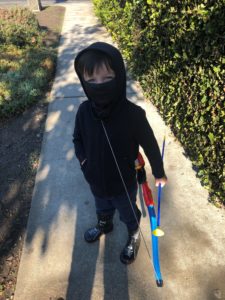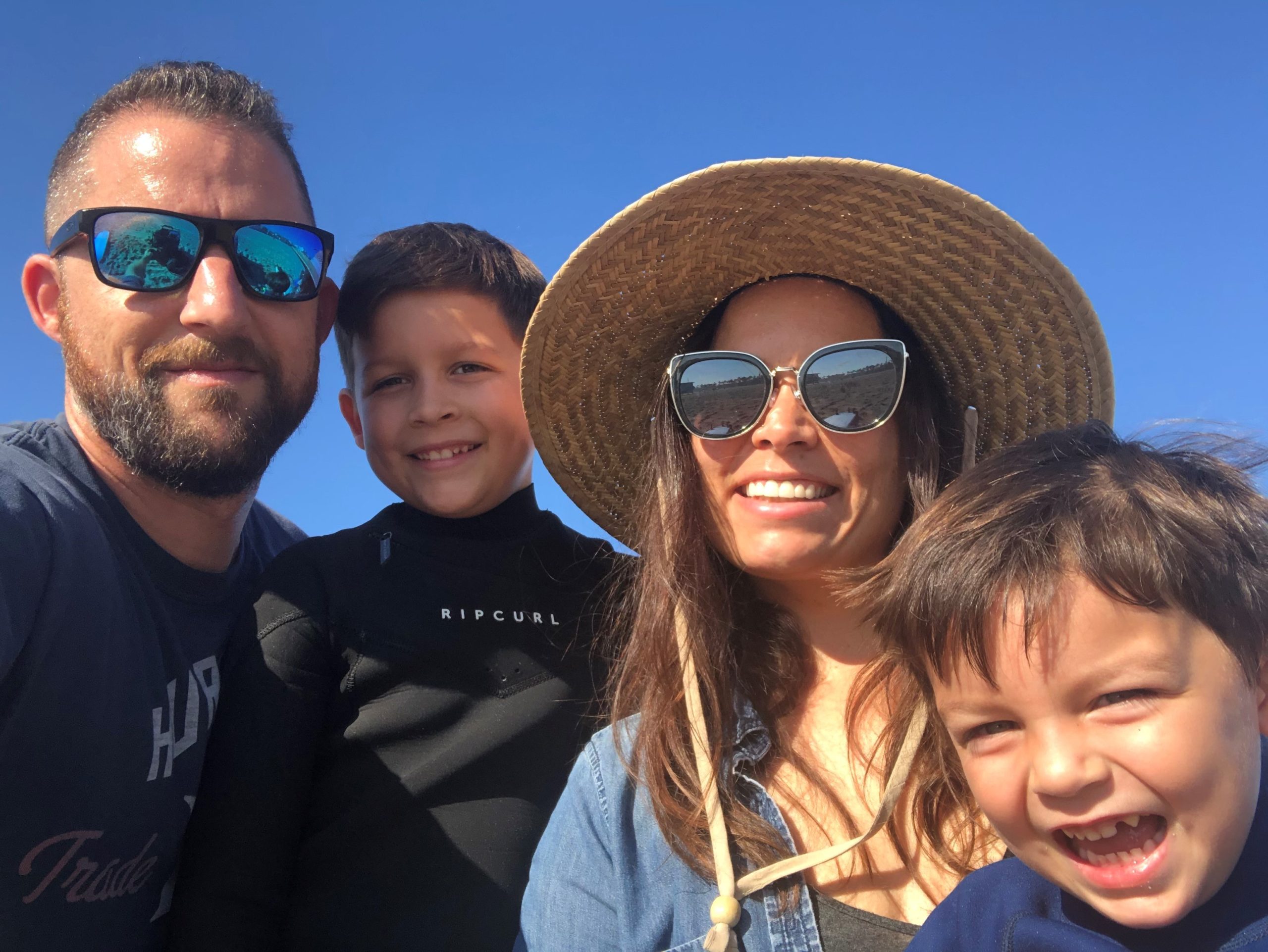By Jillian Robertson, Red Cross communicator
Breanne Williamson is many things to many people. To me, she is a colleague at the American Red Cross Los Angeles Region, where she works as a senior philanthropy officer on the fundraising team. She also is a wife, a mother and, since COVID-19 hit and her children’s schools closed, a teacher. Breanne has two sons — an 8-year-old and a 3-year-old. When schools closed due to COVID-19, it did not change Breanne’s schedule of working full time at the Red Cross or her husband Garrett’s schedule of working as a manager at Trader Joe’s.
Now with the boys at home, the Williamsons had no choice, they had to figure it out and the learning curve was steep.
“We had to dive in and try to become experts in the education space — going to district meetings, talking to other parents,” Breanne said. “We were trying to navigate a space that we hadn’t navigated before — that no one had navigated before.”
A common theme began to emerge when she discussed these matters with other parents and or attended school district meetings. The shutdown was affecting many families in many different ways, and like the spread of the pandemic itself, the changes happened fast.
“We didn’t get any kind of notification until the Saturday before school was supposed to start,” Breanne said. That is when she also found out that her older son would be enrolled in “distanced learning” via video conference from home.
Parents were at odds with each other about this decision: Many supported the decision, feeling it was the best way to keep themselves and their children safe from the virus; . but just as many feared the effect distance learning would have on their children’s education and wanted in-person learning to resume.
There were strong feelings on both sides.
Breanne said she feels lucky because she and her husband are employed, while many of their friends have lost jobs. However, even continuing to work has a downside.
Her husband’s work at Trader Joe’s had introduced many safety issues as colleagues had tested positive for COVID-19. Garrett also is immunocompromised and thus at higher risk for contracting the disease.
Their days began to form a routine: Go to work, risk contracting the virus, stay home and face economic struggle that comes with that choice.
“This is uncharted territory for everyone as a whole,” Breanne said, adding that navigating it with children added another level of difficulty.
To manage their risk, the Williamsons came up with an elaborate ritual, a detailed safety protocol to be followed meticulously each day when her husband came home from work.
“He goes to work. He takes one car. He’s the only one who drives that car. Then he comes home and parks in the garage. He disrobes. He sanitizes everything that he can. Then he comes in and immediately takes a shower before touching anything, before touching any of us. There are no welcome home hugs or anything like that until he’s gotten out of the shower.”
This ritual is non-negotiable, Breanne said, for one simple reason: “It’s protection for us as a whole.”
The fear that her husband might contract the virus puts stress on their entire family, Breanne said. “It’s a fear that we live with every day.”
This is a sobering reminder that not only does COVID-19 affect all of us differently, but that it can compound already challenging situations, such as underlying health conditions. It can complicate simple familiar rituals such as going to school.
Working at the Red Cross
Breanne joined the Red Cross five months before COVID-19 hit. Now, she has spent more time working out of the office than in it.
Regardless, it was enough time for to absorb the message of preparedness safety, and now she is instilling that in her children.
“My kids are great about wearing masks. I told my younger son, ‘You look like a ninja!’ and he’s like, ‘Great, I’ll always wear a mask!’

At three, Breanne said he does not understand the scope of the situation, but he understood the threat more than she realized.
One afternoon while standing on the sidewalk eating a lollipop, a birthday drive-by went down the street. and when another child walked by without a mask, Isaac turned to that kid and shouted “Six feet away! I don’t have my mask on!”
“I was floored by it. He was able to put together the concept of when his face being exposed and when other people are too close to him.”
She was impressed, but also saddened that this had become the new normal for her son.
Silver linings
In light of so much fear and uncertainty, Breanne said she has found a silver lining: the family has spent more time together. Breanne cherishes this time they have had together, a result of the shelter-in-place order and the shutting down of businesses and restaurants.
 While weekends before COVID-19 were split between work, playdates, birthday parties and sports practices, now they are spent at home. “We spend a lot of time together,” Breanne said. Isaac learned to ride a bike without training wheels in the first two months of the pandemic.
While weekends before COVID-19 were split between work, playdates, birthday parties and sports practices, now they are spent at home. “We spend a lot of time together,” Breanne said. Isaac learned to ride a bike without training wheels in the first two months of the pandemic.
Travis, already an avid skateboarder, has started going to the beach with her husband where he is honing his surfing skills.
Before the pandemic, finding time for self-care was not easy. Even now with a less-packed schedule, Breanne still finds carving out time to be difficult.
“I don’t think I’m there yet,” she said. “I try to go for walks as often as I can. I used to be a voracious reader. A book every two weeks. I have not read one book since the pandemic.”
One casualty of school closures has been the built-in childcare it provided. And the option to send kids to their grandparents or to playdates at friends’ houses for a much-needed break has evaporated as well. Those used to be opportunities for self-care.
“It’s a balancing act,” Breanne said. “I’m a full-time employee, a mom, a short order cook, a teacher an IT tech – distance learning. It’s a lot to try to navigate in a day.”
COVID-19 has been disproportionately trying on mothers like Breanne. Women have dropped out of the workforce at an alarming rate during the pandemic and those who have not struggle to balance their many responsibilities.
What’s ahead
As the COVID-19 vaccine rollout continues, it seems like better days are on the horizon.
But looking forward to the future contains as much uncertainty as hope.
Breanne’s younger son was in the queue to start preschool. Preschool in LA is so impacted that parents put their kids on waitlist to enter preschool as early as 4 months old.
Because Breanne and her husband did not want to send him back to in-person preschool, when a spot opened up for him, they passed. Now he is back on the waitlist. “Other people are willing to send their kids back,” they were told.
“We made a decision for our family’s safety and then we lost childcare for an entire year,” Breanne said. The repercussions of this choice highlight just how fraught it is to be a parent during COVID-19.
A personal connection
Breanne misses working and collaborating and brainstorming with her teammates in person. However, her team has found ways to stay connected, having open conversations about how everyone is doing and what everyone needs.
“I’m so appreciative of the Red Cross and the leadership we have in the Los Angeles Region,” Breanne said, emphasizing that going through this pandemic would have been different if she had not been at the Red Cross. Through all the challenges, it has given her purpose.
“You see the need. We come to the Red Cross because we’re humanitarians. We have passion for people, for helping people. Even before the pandemic, there were so many people who needed the Red Cross’s help.”
The challenges Breanne and so many like her face — managing work, health, childcare, family needs and so much more – are not going away anytime soon, and the passion she brings to that daily, many-faceted challenge is constant.
“I give everything to my job and then everything to my family,” Breanne said. “They are not equal, but they are both important for me to feel fulfilled as an employee and as a human being.”





